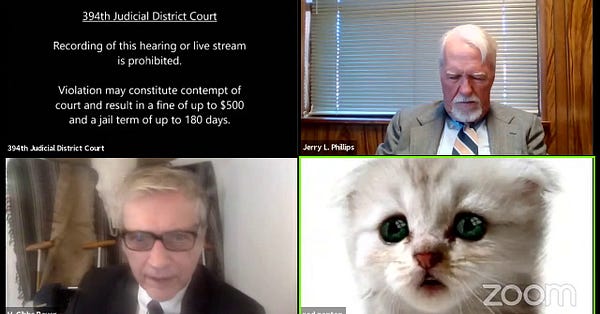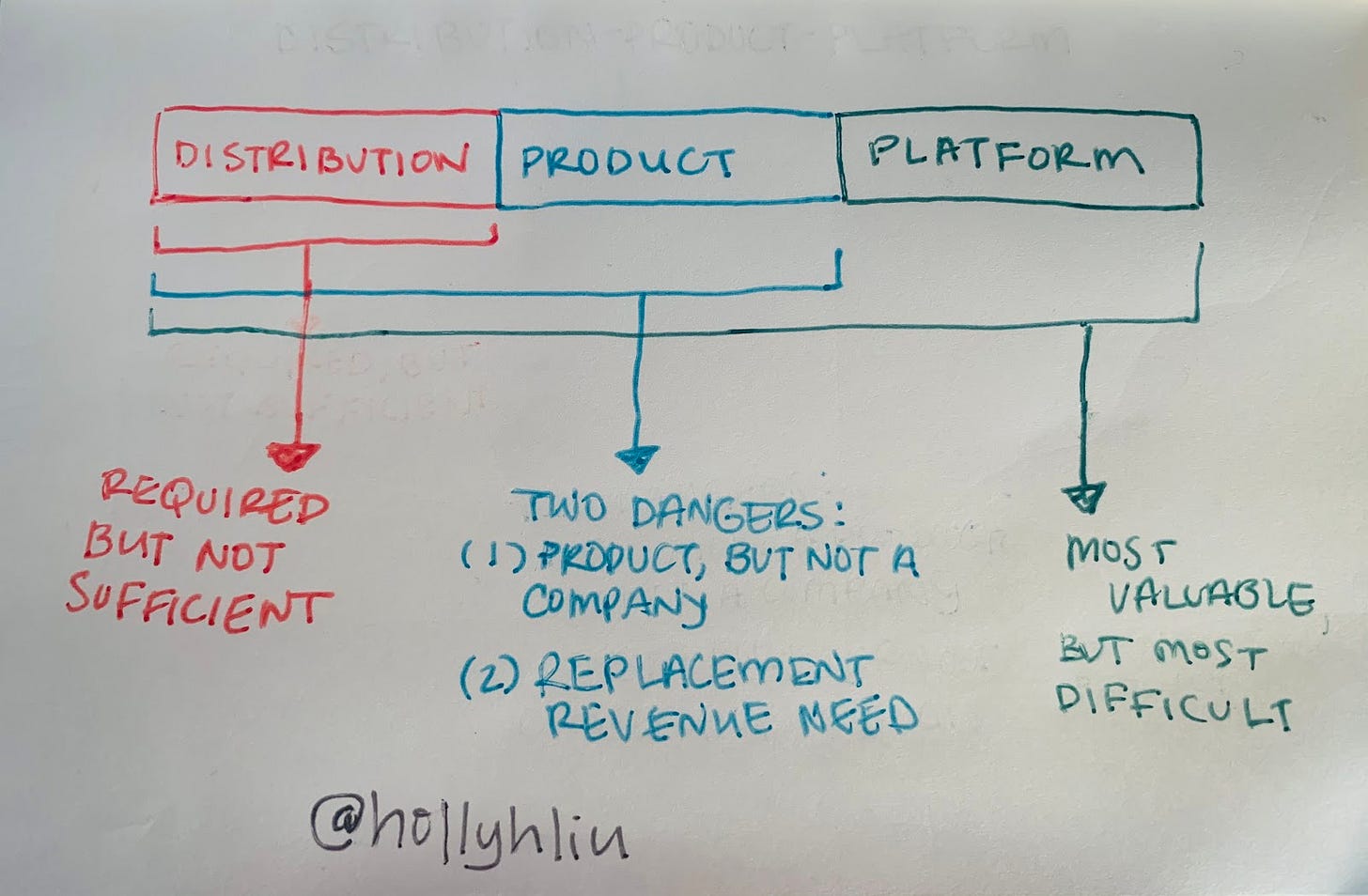Creating the Most Value: Thinking Beyond Product
A Short Primer on the Distribution-Product-Platform Value Chain
There is a saying that first-time founders care about product, second-time founders care about distribution. Experienced founders know they can make anything they want, but it’s hard to get people to want what they make. Successful founders focus on distribution - how will they tell customers about their product or service?
Each startup lives in an ecosystem or value chain comprised of:
Distribution
The way users find out about your product. If no one can find your product then you have no users. Distribution is necessary but not sufficient. And, because it is out of the founder’s control this is the hardest aspect of the value chain to build.
Product
Product (or service) is what the founder builds and offers. Founders have 100% control over what is built, making it easier to control. Product is a single revenue stream and often accessed via a platform. An example would be selling a t-shirt. By itself on a website the t-shirt can make some money, but if you put the t-shirt to sell on Amazon, it can make more money.
Platform
Usually platforms serve several products or services. Sometimes the product belongs to the company and other times the products or services do not belong to the company. (ex: Airbnb shows houses that do not belong to them; Netflix has a mix of original owned content and outside studio content). Platforms serve as more of an intermediary where two parties can connect and exchange a product or service. Platforms can range from a marketplace like AirBnB, to content driven platforms like Netflix. And there are many types of platforms. Platforms are incredibly difficult to build and grow, but can be more valuable. 12
Being a non-CEO founder and previously only at large companies, it took me a while to understand what this meant. I was incredibly focused on product design at larger companies, because we had more specialized people to worry about each step of the product release. We even had our own copy writer (luxurious!). I thought about what was usable and a good design experience, but not necessarily if people wanted it. Or if they did want it, how would they hear about the product.
Understanding all the pieces of the value chain informed my daily decisions as a founder designer. I began to think of the product design as an experience that started beyond our product and expanded past the pixels on the screen. I thought about how customers would discover our product and the ways they’d interact with it. My initial role at the company was product design so understanding business goals became core to the goals of product design.
When I was designing our community apps for TV shows and sports fans on Facebook, we spent a lot of time coming up with features that would incent users to share the app with others. An example of this was a leaderboard of people we called “Top Recruiters” in our community. I wouldn’t have done that had I not understood the ecosystem and value chain. It wasn’t enough to just build something great, you had to get people there (Distribution). Once a fan was there, they only experienced one community because each community was dedicated to one TV show (Product). So, we tried to allow easy access to different TV show fan communities so our fans could interact more. We created a platform where a fan could now come and find all the other communities at once. We also turned on a header to where a fan could easily click into another TV show community (Platform). As a result our fan communities grew to over 30million registered users.
Like building quality revenue, a founder can choose where to build in the value chain. Owning just one piece of the value chain is not as valuable as owning more or even the whole thing.
Distribution: If you just own the users (Distribution) and do not have a platform or product, then you have a mailing list. But, distribution is necessary to the success of your product or platform, but not sufficient.
Product: If you only have a single source of revenue, this means you will need to create replacement revenue. From the customer’s perspective, they can only consume one thing when they visit your site. This is similar to going to a site and primarily being able to just buy one thing.
In our case, we built our first game (Product) and it did so well living inside another platform (Facebook). Our revenues were growing; however, the revenue would not grow forever. We also knew that there were opportunities for different audiences and different themes. So we were cranking out games once a quarter. But, we also needed to drive traffic to each of those games. Each game had a different audience. We launched Kabam.com to create a platform. Once we had a platform we needed to figure out how to drive more players to the platform and get access. By the time we moved our platform onto mobile, we needed to work with Apple and Google to ensure all of our games got distributed. Had we owned the entire chain, our share of revenue would have been greater and also higher-quality.
Platform: If you only have a Platform, but no distribution or product, no one finds out about you (Distribution). When people go to your Platform, but there is no product or services then it’s like going to Netflix and there are no movies in the catalog. One example was Google Daydream - a phone based VR system. “Google’s app selection was lightweight at best.” 3And, eventually Google Daydream was discontinued. There could have been other reasons why Google Daydream was discontinued, but not having anything to do (or enough content) in the platform is a big factor.
The most successful founders will aim to own the whole chain from distribution to product to platform. Think about Amazon or Google or Facebook. Amazon owns the warehouses and fulfillment process, Google owns search, a natural way for people to find their products, and Facebook owns the entire audience, so much so that every $1 that a company raises, about 40% goes to Facebook (and Google). 4
As you are building your startup, think hard about what a lot of people want and how to reach them (distribution). Next, think about your first revenue stream (product), like how Amazon chose books, and then expand into other categories. Then once you own enough categories, open it up to third party sellers along with your own white labeled products (platform). You may turn out to be the next Jeff Bezos. Thank you Jeff Bezos for all the early work you put into building Amazon and all the business lessons you shared along the way. ❤️
WFH Break ❤️🐱
Anyone who hasn’t seen this, please take it as an educational tip as well as a just a great break. It’s waaaaay better than the potato lady. 🥔


🙏 This post took longer for me to write, so a very special thanks to Jen Liao and Karen Hong for reading drafts of this and helping me think through some of the concepts.
❤️Sharing is caring. If you think someone could benefit from this newsletter or post, please share! ❤️


a very good breakdown. these days, if you don't have distro... you die.